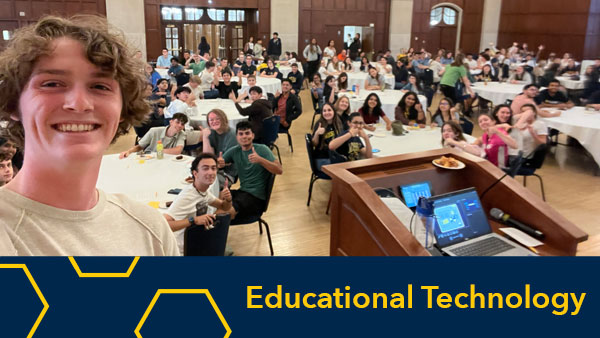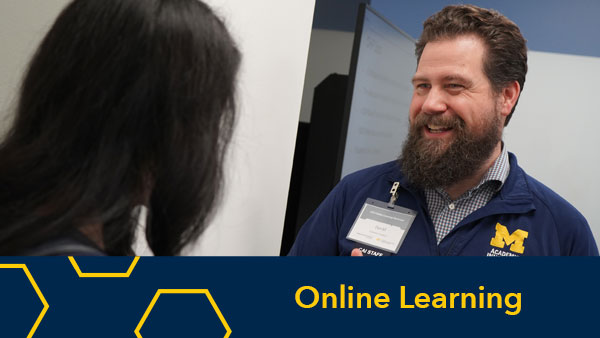James DeVaney, Associate Vice Provost for Academic Innovation and Founding Executive Director, Center for Academic Innovation
In a recent blog post, I commented that now, more than ever, we need to model discourse and democratize discovery. We need new opportunities to engage learners around the world to learn with, and from, each other. This is no small challenge. But we can move intentionally in the direction of providing greater access and facilitating the problem-based learning our society needs if we ground our work in good pedagogy. Better still, we’ll improve our ability to reach the world if we engage with other innovative universities in the design of innovative models for teaching and learning.
To this end, we are exploring new collaborative opportunities to bring together stakeholders across the higher education ecosystem to advance a much needed nationwide network for academic innovation. In our experience, quality collaboration requires the agency to explore, the relentless pursuit of diverse perspectives, and openness to inspiration from unexpected places. Collaboration relies on a foundation of trust and shared values.
 Stephanie Parisi is the Associate Director of Online Education in the Center for Faculty Development and Excellence at Emory University where she supports faculty as they prepare to design and teach online, hybrid, and blended courses. She has partnered closely with the Center for Academic Innovation at the University of Michigan to shape the Teach-Out model, providing invaluable critique and inspiration, and engaging her campus community in the design of new learning experiences that model positive discourse.
Stephanie Parisi is the Associate Director of Online Education in the Center for Faculty Development and Excellence at Emory University where she supports faculty as they prepare to design and teach online, hybrid, and blended courses. She has partnered closely with the Center for Academic Innovation at the University of Michigan to shape the Teach-Out model, providing invaluable critique and inspiration, and engaging her campus community in the design of new learning experiences that model positive discourse.
She and I connected recently to discuss the importance of embracing difficult conversations, opportunities to integrate online and residential learning experiences, the intersection of innovation and social impact, and experimenting with new modes of public scholarship.
Q: What originally motivated you to explore the Teach-Out model? How does it fit with Emory’s strategic vision?
I first learned of the Teach-Out model at a Coursera Partner’s Conference from Lauren Atkins Budde. The University of Michigan and Emory had been grouped together to present for two years in a row for our work around social justice and public scholarship, and when the opportunity arose to collaborate with U-M and learn more about this model, it seemed like a natural fit for the type of work Emory cares deeply about. Emory’s new strategic framework, “One Emory: Engaged for Impact,” challenges our community to step up to the plate in the areas of faculty excellence, student experience, innovation through our scholarship, and unleashing Emory and the city of Atlanta’s shared potential as a catalyst for change in the world. The very nature of the Teach-Out supports each of Emory’s strategic pillars and allows us to work toward our commitment to social impact.
Q: When you participated in the inaugural Teach-Out Academy at the University of Michigan in 2018, you provided insight into Emory’s goals to use pedagogical and technological innovation to create more social impact courses. How has your Teach-Out initiative contributed to Emory’s goals? What did you learn from colleagues from other participating institutions?
What is very appealing about the Teach-Out model is the amount of discussion taking place throughout the life of the event, as well as the call-to-action. Emory does a lot of work in the space of conversations and storytelling. We recognize, and want to teach, that one perspective is not the complete perspective. I would encourage you to watch this brief video from Emory President, Claire E. Sterk, about why embracing difficult conversations is of such importance to the University community.
Talking with other participating universities a year after attending the first Teach-Out Academy at U-M, it was clear we all approached the Teach-Out in different ways. Although I would generalize that most universities creating Teach-Outs are dedicated to making a social impact, how each institution interpreted and developed their Teach-Out(s) was unique. This is seen in the topics selected, the platforms chosen, the development process, and the calls-to-action. And that is the beautiful thing about Teach-Outs — no one is alike, but we’re all doing work of great social importance.
Q: One of your goals with the first Emory Teach-Out was to integrate the Teach-Out with a residential course. How did students within the residential course interact with the Teach-Out content and community and how were the learning experiences linked together?
From my understanding, this was Emory’s unique approach. The lead faculty member, Professor Pablo Palomino, was teaching a “University Course” on campus. Emory offers only one or two of these courses each year, and they include students from all areas of the University. During Teach-Out planning, we explored the idea of weaving the Teach-Out into his residential course in some way because it was an extension of the course topic. Additionally, what a great way to test out our first Teach-Out and get feedback from our students! As part of the class, Pablo asked his students to enroll in the Teach-Out as a participant, but also to moderate and propel conversations in the discussion forums to apply what was being learned in his class. This worked out well because we didn’t have a lot of backend moderating support and didn’t know what to expect in terms of volume. While the Teach-Out was live, Pablo and I teamed up to have small group discussions with his students about their reactions to the conversations with participants from around the world. Some of these discussions were very robust and some were not. The students also encountered the challenge of the Coursera platform’s technical limitations. Although they said they preferred the Coursera platform for its global reach and academic focus, they wanted their discussion experience to mirror social media platforms, like Facebook. Finally, students were asked to complete the call-to-action as part of their in-class assignments. This resonated with some, but not with others. The feedback we received from students was that the call-to-action was too open and didn’t provide enough direction. From the design side, this was done purposefully so that the many participants would have variety and choice. In the future, we’ll look to design a better balance.
Q: Can you describe what it was like to work with faculty and other contributors at Emory to create this new type of learning experience?
The Teach-Out was similar in many ways to previous MOOC projects Emory has worked on. We often have a lead instructor and guest speakers that join in to record video. The difference, however, was in the on-boarding and planning with the lead instructor. After the Teach-Out Academy, it took several months to find the right topic and faculty fit for our first Teach-Out. Thankfully, Pablo Palomino, Assistant Professor of Latin American and Caribbean Studies and Mellon Faculty Fellow with Emory’s Oxford College, was an amazing collaborator. Despite having limited experience teaching online or filming videos, Pablo was so open and innovative in his approach to this project. He was a complete joy to work with and honestly placed a lot of trust in me and my colleagues in the Center for Faculty Development and Excellence. Additionally, we had so many wonderful contributors that were willing to join us from different parts of Emory and the Atlanta community, who jumped in and participated in the live event as well. Though we had a challenging time getting this project off the ground, the wait was well worth it!
Currently, the “Making” Progress Teach-Out can be found on Coursera and on YouTube.
Q: Where do you hope to go next with Teach-Outs at Emory and how are you further exploring the intersection between academic innovation and social impact?
We have already begun development on our next Teach-Out which is based around themes from Emory’s Common Read, Educated, by Tara Westover. We hope to involve faculty and students with diverse backgrounds and use this Teach-Out as a springboard into conversations and telling stories around our journeys to, and through, education — as that can mean many things. We all move through the world in different ways and we each have a pathway that is uniquely our own. This Teach-Out aims to bring together the sharing of those journeys by highlighting examples from the Emory community and guiding participants in how to share and exchange their own journey. Topics in this Teach-Out include definitions of education; first generation students; the role of family, race, and religion; imposter syndrome; and formal and informal education. There is something in this Teach-Out for everyone, whether you’ve attended college or not.
Emory is always looking at ways to make a social impact through our scholarship and by engaging with, and beyond, our communities. The Teach-Out model fits nicely as it allows us to consider and explore other ways of thinking about public scholarship, social impact, and innovation. With Emory’s new Strategic Framework, “One Emory: Engaged for Impact,” innovation and social impact is a cornerstone to much of the work we do. This can be seen in a variety of events, projects, and research happening around the University and Healthcare units.
Q: What advice would you give to other institutions who are interested in exploring the Teach-Out model?
Try it! The development process is just as rewarding as the final product. It allows you to work outside the box of MOOCs, fully online courses, and webinars, and challenges you to think of public scholarship and social impact in different ways. There are so many different approaches to Teach-Outs, and so I encourage and challenge you to take it in a direction we’ve not seen yet.
Additionally, I think it is important to note the role of U-M’s Academic Innovation team. Not only have they been welcoming and collaborative colleagues, but they openly support you along the way, make time for you, and appreciate the exchange of ideas. It’s clear how much the team supports the true exploration of academic innovation, not just at their university, but in the world. They very much have a “we’re all in this together” attitude and they lead by example. I personally feel honored to work and collaborate with them.
Q: Are there any other examples of innovation in higher education that you are particularly excited about?
There are so many institutions out there doing great work. What I’m really excited about is the role of design thinking in academic innovation and the outcomes we’re starting to see. Just in the past couple years, the collective motivation to take teaching and learning experiences to the next level have been incredible. The current and upcoming generations are not satisfied with the limited abilities of technology-supported learning and we are diving right into those tough problems and starting to see solutions. I’m excited to see this evolution, and I’m excited to be a part of it.


